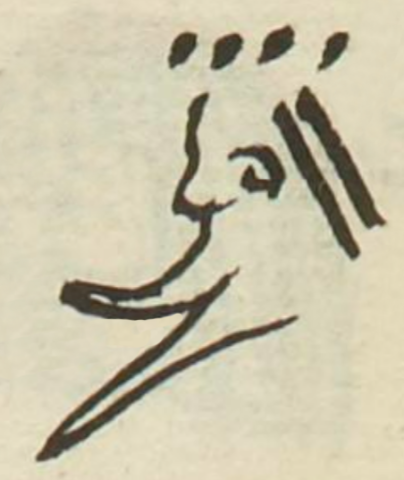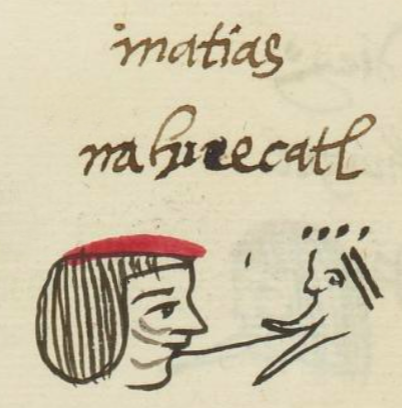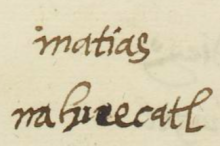Nauhecatl (MH507r)
This black-line drawing of the compound glyph for the personal name "Four Air/Breath" (Nauhecatl) or "Four Wind" (Nauhehecatl) is attested here as a man’s name. It shows four dots running horizontally above the head of a figure in profile, facing toward the viewer's left. The mouth has the shape of a beak (which Nahuas seem to have perceived rather as a blowing device). The visible eye is open. Two vertical black lines appear on the edge of the face. Because this is obviously a day name with a notation from the calendar, and so Ehecatl was probably meant over Ecatl for this person's name.
Stephanie Wood
Gabrielle Vail and Christine Hernández (Re-Creating Primordial Time, 2013, ) describe Ehecatl as the wind aspect of Quetzalcoatl, and they note that Ehecatl "wears a buccal (duck) mask through which to blow wind." That the "beak" may have been perceived as a blowing device is supported by the glyph for Pitztli (below).
John Montgomery drew a group of wind glyphs (possibly mainly Mixtec), showing the variety of ways the blowing device might look. It is published in FAMSI, Inc.
A great many glyphs in this collection start with Eca- when Ehecatl is expected, given the iconography. The gloss here gives "Ecatl," but the visuals suggest "Ehecatl." We are recognizing the possibility of an unintentional oral abbreviation of Eheca- to Eca-. But, if the shortening of the name is intentional, it may be a response to the edict of 1540 prohibiting the naming of Nahua children after deities that led to a favoring of Ecatl over Ehecatl, as a kind of disguise. See Norma Angélica Castilla Palma, "Las huellas del oficio y lo sagrado en los nombres nahuas de familias y barrios de Cholula," Dimensión Antropológica v. 65 (sept.-dic. 2015), 186. Castilla also notes the pressure to give up calendrical names from the tonalpohualli, and this is one of those names.
The black line (face paint?) across this man's face has yet to be analyzed fully, but in this manuscript at least, it is a diagnostic feature of Ehecatl.
Stephanie Wood
matias nahuecatl
Matías Nauhecatl
Stephanie Wood
1560
Jeff Haskett-Wood and Stephanie Wood
viento, wind, deities, deidades, fuerzas divinas, divine forces, números, numbers, ones, unos, nombres de hombres

nahui, four, https://nahuatl.wired-humanities.org/content/nahui
eheca(tl), wind, breeze, movement of the air, https://nahuatl.wired-humanities.org/content/ehecatl
eca(tl), breath, air, https://nahuatl.wired-humanities.org/content/ecatl
Cuatro Viento, o 4-Viento
Stephanie Wood
Matrícula de Huexotzinco, folio 507r, World Digital Library, https://www.loc.gov/resource/gdcwdl.wdl_15282/?sp=93&st=image
This manuscript is hosted by the Library of Congress and the World Digital Library; used here with the Creative Commons, “Attribution-NonCommercial-ShareAlike 3.0 License” (CC-BY-NC-SAq 3.0).







